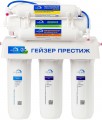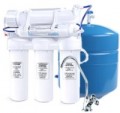Number of flasks
The number of flasks in the filter makes it clear how many
water cartridges can be installed in it. For a filter for sink, in most cases there are
three flasks. If we are talking about reverse osmosis, then flasks do not mean a membrane, post-filter, etc. since their installation does not provide a separate container. But these types of processing are taken into account in the stages of cleaning. The most obvious difference in the number of flasks is observed in the main filters, where the predominant weight per
1 flask, but there are also
models for 2 flasks or even more.
Filtration speed
The amount of water that the filter is able to pass through itself per unit of time (of course, effectively purified in the process); usually stated in liters per minute. This parameter is largely related to the type (see above): for example, in jugs, the filtration rate usually does not exceed 0.5 L per minute, while for main devices that supply entire apartments, a throughput of tens or even hundreds of liters is required.
Note that it does not always make sense to pursue a high filtration rate. After all, other things being equal, finer cleaning takes more time; accordingly, the faster the filter works, the higher the chance that the quality of such cleaning will be relatively low. And devices that purify water efficiently and quickly usually have an appropriate price. Therefore, it is worth considering the purpose of the filter and, on the basis of this, determine the balance between the filtration speed and its quality when choosing. It is also worth keeping in mind the conditions of use: for example, if you need to filter low-quality tap water for drinking, it is better to sacrifice speed in favor of efficiency.
Resource
The resource can be described as the total amount of water (in thousands of liters) that the filter is able to clean before the cartridge needs to be changed. Usually, it is indicated for a standard filter element (see "Removable cartridges").
Different types of filters (see above) can significantly differ in resource, depending on the features of their application. However, for all models, the rule applies: do not use a cartridge that has exhausted its resource. This is due not only to a drop in filtration efficiency — an “overfilled” filter can begin to release the accumulated contents into the water, further degrading its quality. Since it can be quite difficult to monitor of a specific amount of treated water, many manufacturers indicate the approximate time in which it will be exhausted with an average intensity of use in addition to the resource. Usually it is a few months, but there are exceptions. In addition, for the convenience of the user, various indicators can be provided in the filter design (see "Cartridge replacement indicator").
In models with a multi-stage design (see "Stages of purification"), where there are several cartridges, their resource usually differs, and the total filter resource is usually indicated by the least durable cartridge, that is, until the first replacement of any of the filter elements.
Types of filtration
Substances from which the filter is able to purify water. Some models may also indicate a specific degree of purification in percent for each point; the higher this indicator, the more efficiently the filter is able to cope with its functions. This list will be especially useful if you know what exactly is the most polluted water in your area — it will allow you to choose the model that is most suitable for specific conditions. In addition, in the case of softening systems (see "Type"), this data helps to determine the specific type of device — softener or iron remover.
The most common contaminants today are:
—
Mechanical impurities. Particles of small size, insoluble in water and in a state of suspension. An example of such impurities is fine sand.
—
Organic impurities. Impurities of various substances of organic origin — benzene, chloroethanes, chlorethylenes, etc. Many of these substances are harmful to humans. Unlike the mechanical impurities described above, "organics" refers to chemical contaminants — such substances dissolve in water, and they have to be filtered at the molecular level. This requires the use of fairly advanced filters. It is also worth mentioning that some types of organic substances — in particular, phenol, pesticides and petroleum products — stand out in separate categories, the possibility of filtering them is specifically stipulated in the specs
...of the filters. This is due to their prevalence and popularity: the term "organic impurities" is not clear to everyone, but the danger of pesticides or petroleum products is well known. See below for details on individual types of organic contaminant.
— Active chlorine. Chlorination is still used in some plumbing systems as a disinfectant. As a result, water supplied to consumers often contains dissolved chlorine, which is harmful to health. Some filters with this function, in addition to chlorine, are also able to remove hydrogen sulfide and other gases dissolved in it, which affect water quality and give it an unpleasant odour. However, these possibilities should be specified separately.
— Iron. Iron is known to many as an important trace element necessary for the functioning of the body; however, a person needs very little of it, and iron impurities in drinking water only harm the body. Note that such impurities can be present in different forms; therefore, different types of filters are required to filter them. So, one of the most famous options is colloidal iron: very small undissolved particles that give the water a characteristic “rusty” colour, as well as a metallic taste and smell. This type of impurities is effectively filtered by osmotic membranes (see "Reverse osmosis"). Also, such membranes cope well with bacterial iron — it is also in the form of insoluble microscopic particles, accumulates a specific type of bacteria that lives in water pipes. But for soluble forms (ferrous hydroxide, chloride and ferrous sulfate), it is necessary to use specialized cleaning and softening systems — iron removers; see "Type" for details. Summing up, we can say that when choosing a device with this type of filtration, it is necessary to take into account the specific form of iron that you have to deal with. At the same time, water can contain several types of such impurities at the same time, which may require complex filtration.
— Ions of heavy metals. In this case, we can also talk about salts of heavy metals: ions are formed when any salts are dissolved in water. Most heavy metals — accordingly, their compounds — are toxic to humans.
— Pesticides. Various chemicals used to combat harmful microorganisms, fungi, weeds, various agricultural pests (insects, rodents), etc. Most pesticides are toxic chemicals and are toxic to humans.
— Nitrates. Salts of nitric acid, which are a common component of mineral fertilizers (saltpeter) in particular. Most of the nitrates are converted into safe compounds during use, but excess fertilizers can end up in drinking water.
— Cadmium. A metal used in particular in anti-corrosion coatings, batteries and inorganic dyes. Poisonous both by itself and in various compounds.
— Petroleum products. Oil and various substances obtained from it (gasoline, kerosene, diesel fuel, fuel oil, etc.). It is poisonous when taken orally.
— Hardness salts. Compounds that give water increased hardness are primarily calcium and magnesium salts. Water purification from such salts is carried out by purification and softening systems based on the principle of ion exchange. For more information about such devices, see "Type", here we note that if the specs of the cleaning and softening system indicate the filtration of hardness salts, then we have a classic softener, if not — an iron remover.
This list is not complete, modern filters can specialize in other types of pollution. For example, for many main models (see "Type"), filtration from sand and clay is separately claimed. In our catalog, such moments are described in the paragraph “Additional cleaning".Water mineralization
The presence of a
water mineralizer in the filter design. The mineralizer is usually a container filled with a special slowly dissolving mixture. Thanks to it, filtered water is saturated with various micronutrients: calcium, potassium, fluorine, ferrous (of course, not harmful colloidal ferrous, but another easily digestible form) and others. They have a positive effect on the human body and improve the taste of the water itself compared to completely purified water.
Mineralizers are found mainly in filters equipped with reverse osmosis systems (see above): the fact is that during the operation of such systems, not only harmful impurities are removed from the water, but also the mentioned micronutrients that got there naturally.
Min. operating pressure
The lowest inlet water pressure at which the filter is able to fully perform its functions. Indicated for models with a connection to the water supply — directly or through a tap (see "Connection").
The design of some filters requires a certain level of inlet pressure for normal operation; if the pressure is insufficient, both throughput and overall filter efficiency suffer, and some functions are not available at all. The latter is especially true for reverse osmosis (see above). Therefore, if the minimum operating pressure is directly indicated in the filter characteristics, you should make sure that your water supply system complies with this parameter before purchasing.
Note that for filters with a booster pump, this column indicates the lowest pressure at which the filter still does not require the use of a pump; see "Pump" for details.
Max operating temperature
The highest inlet water temperature at which the filter is able to operate normally. Modern filters are conditionally divided into models for cold and hot water: the operating temperature in the first case does not exceed 40 °C, and in the second it can reach 95 °C. For more information on the importance of matching water temperature and filter characteristics, see "Purpose".
Replacement cartridges
Models of replaceable cartridges for which the filter is designed. Knowing the names of models, it will be much easier for you to find a replacement for an exhausted cartridge. In addition, the options directly named by the manufacturer are fully compatible with the filter and correspond to official specifications, while there is no such guarantee for "non-native" cartridges.
Several names in this paragraph are usually indicated for filters with multi-stage filtration (see "Stages of purification") — a cartridge for each stage.

